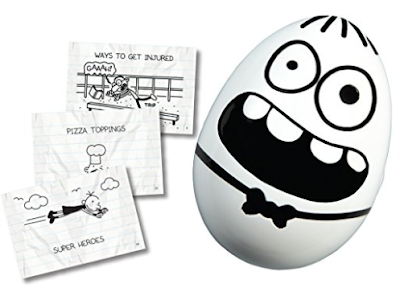 |
| Wimpy Kid - Don't Scramble the Egg |
When I picked up the box I thought it was empty, so first off, few contents for your money. However, I like the game Hot Potato, so when I saw this I decided to purchase it, even though a little voice said that throwing something made of hard plastic probably wouldn't end well. Isn't it interesting how often that little voice is correct.
The hard plastic egg is a timer, about 4" tall and requires two batteries. Timer speeds are short and random, you don't know if the timer will go off in 15 seconds or 30 seconds, etc. Unlike Hot Potato, you will win if you ARE holding the egg when the timer goes off. It won't take kids long to figure out if they "pause to think" they have a better chance of holding it until it cracks (timer goes off).
We started playing the game by rolling the egg across the table instead of throwing it. The individual I rolled it to missed it and it fell about three feet to the tiled floor. Upon impact the door to the batteries, that I had carefully screwed back into place after inserting the batteries, flew off. Both batteries flew out and the egg rolled in the opposite direction. Pieces scattered everywhere. That is after hitting the floor for the first time. I wonder what would have happened to it if it had been thrown, with a little force behind it.
The 50 category cards each have one category printed on them, such as things to play with in the water, types of storms, little kids' shows, ways to get injured, and ways to move fast. When the timer goes off it will make the sound of a cracking egg.
I wouldn't recommend this. Stick with Hot Potato, or toss an item of your own choosing, and make your own category cards if you like that feature.
Object:
Be the person with the most cards at the end of the game.
Set up:
Unscrew the door to the battery compartment, insert 2 AAA batteries, replace the door. Shuffle and place the category cards in a pile next to the players.
Play:
Choose a category card, push the button on the side of the egg to start the timer, name one item from the category, and throw the egg to someone else. The person who catches the egg must name one item from the category and throw the egg to someone else. Keep this up until the timer goes off. If you are holding the egg when the timer goes off you get the card. The person with the most cards at the end is the winner.
Work on eye-hand coordination, manual dexterity, socialization skills, coordinated use of both hands, balance, motor planning, spatial relations/position in space, visual tracking, executive functioning skills, process skills, play and leisure exploration and participation
In the box: Hard plastic egg (requires 2 AAA batteries), 50 category cards




